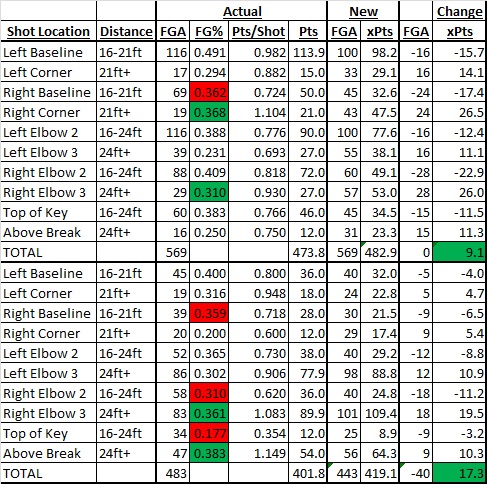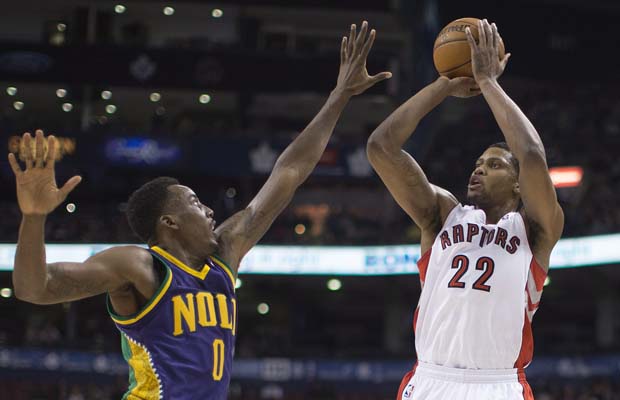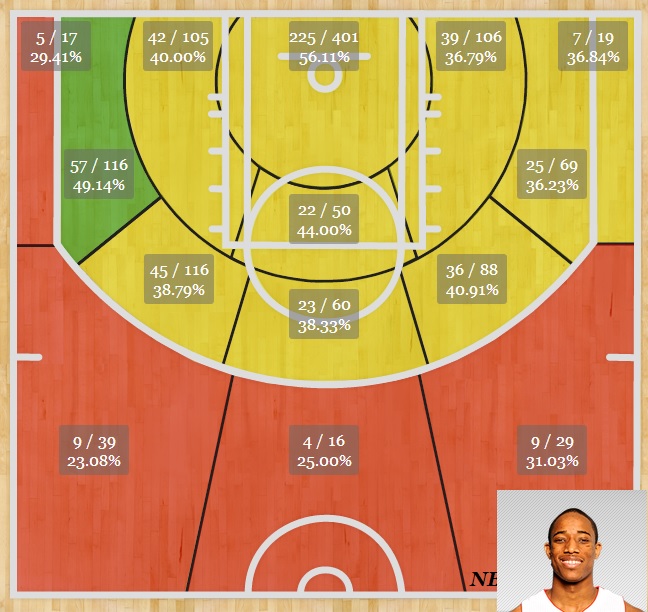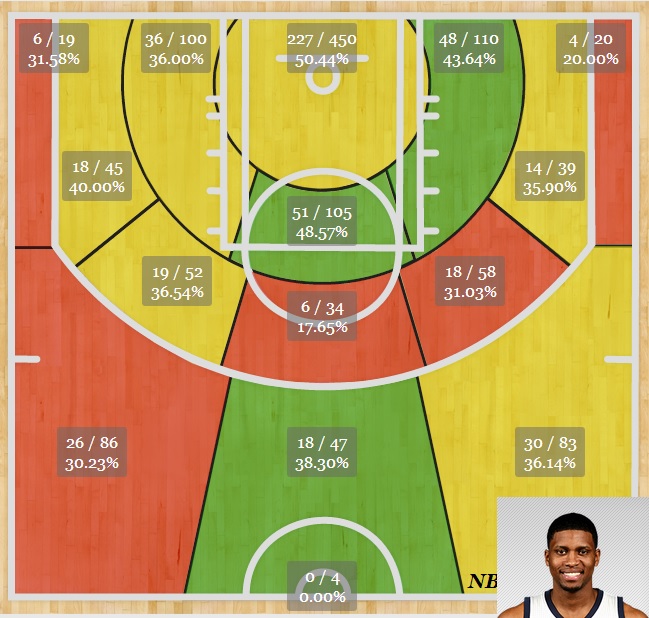Long two’s are the worst shot in basketball. Shots closer to the rim have a better chance of going in and a higher rate of drawing a foul on the shot, while baskets from beyond the three-point line are worth more points.
Three > Two
Or
3 > 2
Of course, players don’t shoot as well from further away as they do from closer. But the difference between, say, a 19-footer and a 24-footer probably isn’t as big as you’d think in terms of success rate. The difference in expected points from said shots, though, is.
40% on long twos = 0.8 points/shot = 26.7% on threes
Or
50% on long twos = 1.0 points/shot = 33.3% on threes
It’s really not hard to see how taking a step back or focusing your offensive game to be more perimeter-oriented can help an offense by lowering the threshold for makes for an efficient offense. Beyond just that simple math, three-point misses result in a higher rate of offensive rebounds, resulting in more second chance opportunities than two-point shots. There are potentially additional gains, too, from better floor spacing, preventing a defense from doubling or helping as well in the post or on dribble penetration.
This is all fairly logical stuff, but it’s logic that appeared to be lost on the Toronto Raptors last year. While I know their analytic department would prefer those long twos to become threes, their roster includes two players who shoot a high volume of long two pointers in Rudy Gay and DeMar DeRozan. Gay and DeRozan are both mediocre long-range shooters but are fairly adept at creating space and getting their shot off in the mid-range, which could clearly encourage such sub-optimal shot distribution.
But what if Gay and DeRozan made a concerted effort to turn some of their long two-point attempts into three-point attempts? I took a crack at breaking down the numbers to find out what impact this could have on the Raptors’ offense.
Altered Shot Distribution
It’s unrealistic to suggest Gay and DeRozan could/should have changed all of their twos to threes, but DeRozan was second in the league in attempts from 16-23 feet, while Gay was 23rd as a Raptor. What if we move their proportion of long-twos and threes to that of a more standard distribution?
The median team attempted about a split roughly as follows (percentages are as a percent of all shots longer than 15-feet, since we’re only comparing long-twos to threes, not the overall shot mix): 35% 15-19 feet, 28% 20-24 feet twos, 13% 20-24 feet threes, 24% 24-plus feet.
Rough league Median: 35% 15-19 feet, 28% 20-24 feet twos, 13% 20-24 feet threes, 24% 24-plus feet
Gay: 38% 15-19 feet, 14% 20-24 feet twos, 18% 20-24 feet threes, 30% 24-plus feet
DeRozan: 59% 15-19 feet, 22% 20-24 feet twos, 10% 20-24 feet threes, 8% 24-plus feet
So Gay’s distribution is actually closer to the league median distribution than I anticipated, at least during his time as a Raptor. But let’s ask Gay and DeRozan to move some of their shots from long-twos to threes and see what happens. You’ll notice even in places where a player shoots poorly from three, I’ve moved some long twos to threes, either because of small samples making me think the player may eventually shoot better from that spot and/or the second-generation benefits (offensive rebounding, spacing) of three-point attempts.

As you can see, by making a few tweaks here and there we can add a few points onto DeRozan and Gay’s bottom line. If all of this seems like a lot of work for a small gain, fine, but it’s just an experiment meant to show that the players can make gains if their profile changes to a more efficient one. If I changed ALL the 16-plus foot twos to threes (an extreme and unrealistic scenario), Gay would see a 65 point boost and DeRozan a 14 point boost, so the effect can be very real.
Offensive Rebounding Impact
Depending on where exactly a three comes from, the offensive rebound rate on three-point attempts is anywhere from 22.4% to 25.3%. For mid-range or long twos, that range is from 19.7% to 23.2%. So we can expect roughly a 2-3% increase in offensive rebound rate when we move from a long-two to a three.
In our hypothetical, Gay and DeRozan combined to transfer 152 shots from long-twos to threes. There would also be 10 additional misses thanks to shooting more threes, for a rough total of 162 extra offensive rebounds available. With a 2.5% bump in offensive rebound rate, the Raptors could have been expected to grab an additional four offensive rebounds. Since the Raptors scored about 1.03 points per possession, that’s another four points on top of the gains from Gay and DeRozan shooting a more efficient distribution. The more extreme the distribution changes, the more extreme the second-chance effect would be as well (that is, in the hypothetical where all their long twos become threes, the team would have moved 677 shots from two to three with an additional 61 misses, leading to an extra 18 or 19 offensive rebounds and an extra 20 points or so). Another note: I believe teams score off of offensive rebounds more than in normal sets, but I couldn’t find the numbers to back this up.
Altering the Team Strategy
The Raptors aren’t, or weren’t, equipped with great three-point shooters. But we’ve shown here that making changes to the shot mix can have an impact on point production, even with guys who are decent in the mid-range and aren’t great from outside. If Gay and DeRozan abandoned all twos greater than 16 feet for threes, the team would have gotten an additional 99 points this season. If the change was even a bit moderate, as in the table above, they would have expected an additional 30 points from these two and the change in second chance opportunities.
We also haven’t accounted for floor spacing and the impact that might have on other players shooting in the mid-range or getting to the rim, and we haven’t accounted for the fact that the team could also alter their crashing strategy to get even more value from the offensive rebound effect here.
All of this is highly hypothetical, but I’ll take you back to our original over-simplified math proofs:
Three > Two
Or
3 > 2
40% on long twos = 0.8 points/shot = 26.7% on threes
Or
50% on long twos = 1.0 points/shot = 33.3% on threes
So get in the gym, guys, and fire up those corner threes. Abandoning some long-twos for three-point looks could have an appreciable impact on your scoring rate and the team’s offense.



